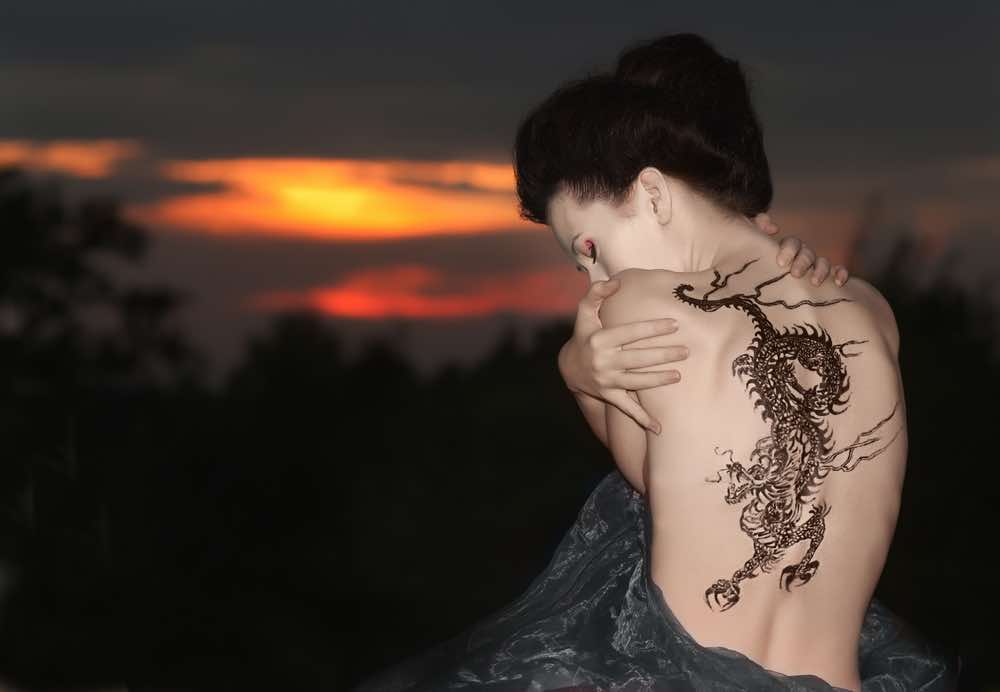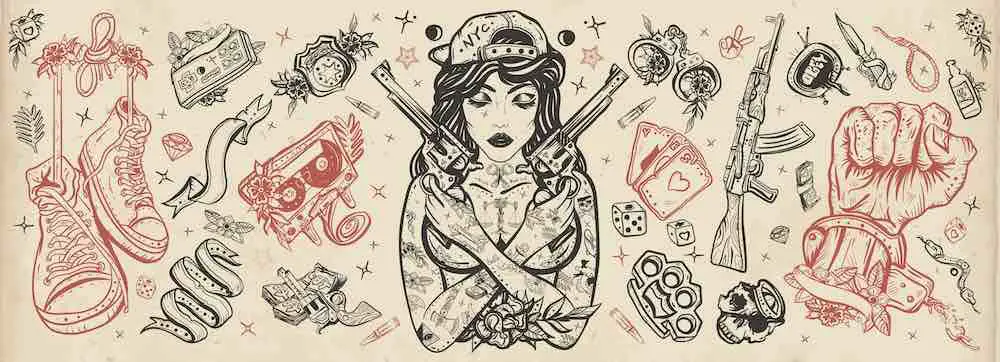Japanese tattoo style, also known as Irezumi, Wabori, or Harimono, is a traditional art form with deep cultural roots and a rich history. Originating in Japan, this style features bold motifs, detailed imagery, and vibrant colors that capture the essence of its meaningful symbolism. Drawing inspiration from historical events, mythology, and folklore, Japanese tattoos tell stories, convey spiritual beliefs, and serve as amulets for protection.

Over the years, Japanese tattooing has evolved through various styles, techniques, and cultural influences. Classic elements include Koi fish, dragons, geishas, samurais, and tigers, each embodying distinct meanings and characteristics. The use of bold ink colors adds life and depth to these intricate designs, making them visually impactful and memorable.
With an increased appreciation for traditional tattoo artistry, Japanese tattoos have gained worldwide recognition, transcending borders and bridging gaps through a shared passion for this ancient yet still evolving form of expression. However, it is crucial to approach this art with cultural sensitivity and understanding, acknowledging the complex relationship between Japanese tattooing and its traditions.
Key Takeaways
- Japanese tattoo style is a traditional art form with rich symbolism and cultural roots
- Classic elements such as Koi fish, dragons, and samurais carry distinct meanings
- Cultural sensitivity and understanding is necessary when approaching Japanese tattoos
History of Japanese Tattoos
Japanese tattoos, also known as Irezumi, have a rich and extensive history that can be traced back to 5000 BCE. The earliest evidence of tattooing in Japan comes from the faces of clay figurines found during this time. Tattoos were initially used for tribal and cosmetic purposes, and both men and women were known to be tattooed.
During the Edo period (1603-1868), the art of tattooing started to evolve and became more sophisticated. This period in Japan’s history was marked by great cultural advancements, and Irezumi began to flourish as an art form. The tattoos at this time were intricate and highly detailed, often featuring mythological and natural motifs, such as dragons, koi fish, and cherry blossoms.
However, the perception of tattoos in Japan shifted significantly during the Meiji period (1868-1912). The Japanese government sought to modernize the country, and tattoos were seen as something primitive and undesirable, especially by the upper class. As a result, tattooing was banned, and the practice went underground. It was during this time that the connection between tattoos and criminality, particularly the association with the Yakuza (Japanese organized crime syndicates), became more prevalent.
Despite the ban, the tradition of Japanese tattooing persisted, and after World War II, when the ban was lifted, the art form slowly began to regain its reputation. The unique style and techniques of Irezumi, such as Tebori (the ancient hand-poking method), continued to be practiced and passed down.
Today, Japanese tattoos are celebrated for their distinctive style, symbolism, and craftsmanship. The influence of Irezumi can be seen in tattoo styles and designs worldwide, with many enthusiasts drawn to its unique blend of ancient tradition and intricate artistry.
Traditional Japanese Tattoo Elements
Traditional Japanese tattoos, also known as Irezumi, Wabori, or Harimono, are known for their bold and vibrant motifs. The elements used in these tattoos are deeply rooted in Japanese culture and mythology, often representing various virtues, protection, and spirituality.
Animals play a significant role in Japanese tattoos, each symbolizing different attributes. Some popular animal motifs in this style include:
- Dragons: Known for their power, strength, and wisdom, dragon tattoos are an iconic symbol in Japanese tattoo art.
- Tigers: Similarly, tigers represent strength, fierce protection, and power, and are often depicted in dynamic, aggressive poses.
- Snakes: Symbolizing transformation, rebirth, and protection from illness, snakes are a common element in Japanese tattoos.
- Phoenix: As a legendary bird that rises from its ashes, the phoenix signifies rebirth, immortality, and spiritual growth.
Other mythical creatures found in Japanese tattoo art include the mischievous Oni (demon), the shape-shifting Kitsune (fox), and the revered Kirin (a mythical beast resembling a deer or dragon).
Prevalent in traditional Japanese tattoos are various masks, such as the fierce Tengu mask, representing protective deities and supernatural beings associated with spirits, nature, and warfare.
Samurais, the famous warriors of Japanese history, are also common subjects in traditional Japanese tattoos. Their depictions represent courage, honor, and loyalty. Similarly, Geishas are featured as symbols of beauty, grace, and artistic skill.
Water-dwelling creatures like Koi fish often appear in Japanese tattoos, symbolizing perseverance, good fortune, and courage. The Baku, a dream-eating chimera, is believed to ward off evil spirits and nightmares, making it another popular tattoo motif.
Finally, clouds are a common design element in Japanese tattoo backgrounds, bringing a sense of depth and motion to the tattoo. They also have a spiritual significance, connecting the earthly realm to the otherworldly sphere.
Imagery and Symbolism
Japanese tattoo styles, also commonly referred to as Irezumi, Wabori, or Harimono, are rich in imagery and symbolism. This section will explore the meaning and significance behind various nature symbols, folklore and legends, and religious and spiritual themes associated with Japanese tattoos.
Nature Symbols
Japanese tattoo designs often integrate various elements of nature to represent different characteristics. Some of these symbols include:
- Cherry blossoms: Representing life, death, and the fleeting nature of existence; often symbolizes beauty, respect, and purity.
- Koi fish: Symbolizing courage, strength, and perseverance against obstacles; also associated with wealth and prosperity.
- Dragons: Often representing wisdom, power, and protection; dragons in Japanese tattoos also signify balance and the mystery of the cosmos.
- Clouds: Symbolizing life’s ever-changing nature and the unknown; often provide a backdrop for other tattoo elements, emphasizing power or passion.
Folklore and Legends
Japanese tattoos often draw upon elements of folklore, legends, and tales of mythical creatures. Some of these themes include:
- Samurai: Representing honor, loyalty, and the warrior spirit; samurai-themed tattoos often symbolize the wearer’s personal integrity and adherence to a code of conduct.
- Oni (Demons): Symbolizing evil or misfortune, these mythical creatures are often depicted as fierce protectors or as warnings for the consequences of negative actions.
- Kitsune (Fox Spirits): Representing wisdom, cunning, and the ability to transform; kitsune tattoos symbolize transformation or the need to adapt to face life’s challenges.
Religious and Spiritual Themes
Japanese tattoos can also incorporate religious and spiritual themes such as:
- Buddhist and Shinto images: Including but not limited to various deities, protectors, and spiritual beings that symbolize aspects of life such as suffering, comfort, healing, and enlightenment.
- Tattoos related to the Yakuza: Traditionally associated with organized crime in Japan, Yakuza tattoos often feature bold, intricate designs with themes of power, loyalty, and the underworld.
No matter the symbolism or imagery chosen for a Japanese tattoo, the designs remain intricate and highly detailed, offering a rich representation of the wearer’s values or aspirations.
Colors and Meanings
Japanese tattoo style, also known as Irezumi, Wabori, or Harimono, is known for its vibrant colors and bold designs. Each color carries symbolism and meaning within the Japanese culture. Here, we will explore the meanings and symbolism of some common colors used in Japanese tattoos.
Red is a powerful and energetic color in Japanese tattoo art. It represents strong emotions, passion, and love. Red is often used in tattoos to depict power, strength, and fearlessness. It can also symbolize the life force and vitality of an individual.
Black carries a deep meaning in Japanese culture. It is often associated with the spiritual world, protection, and mystery. In tattoos, black is typically used to create bold lines and add depth to the design. It also represents a strong and calm demeanor.
Blue is another frequently used color, symbolizing wisdom, loyalty, and trust. It can also represent calmness and serenity. In Japanese tattoos, blue is often used in water-related elements, as it is closely tied to the natural world.
White is considered a sacred and pure color in Japanese culture. It represents purity, innocence, and spirituality. Additionally, white is also associated with the idea of a fresh start or renewal. In Japanese tattoos, it is often used as a complementary color to add contrast and lightness to the design.
Yellow is the color of happiness, warmth, and energy in Japanese culture. Yellow in tattoos can signify wealth, prosperity, and good fortune. It is also seen as an auspicious color and is often used in designs that represent luck and good health.
Pink carries a gentle and loving energy. It is often associated with compassion, romance, and the bonds between people. In Japanese tattoo art, pink is sometimes used to depict cherry blossoms, which signify the beauty, fragility, and transience of life.
Gold is a symbol of wealth, success, and power in Japanese culture. It is often used to highlight the importance of certain elements in tattoo designs, as well as representing the spiritual aspect of an individual.
Japanese Tattoo Styles and Techniques
Japanese tattoos, also known as Irezumi, Wabori, or Harimono, have a rich history in Japan’s culture. The traditional tattooing style is recognized by its emblematic motifs, bold shading, and readability. This section delves into various Japanese tattoo styles and techniques, such as Tebori, Wabori, Black-and-gray, and Modern Take on Traditional Irezumi.
Tebori
Tebori, which translates to “hand-carved,” is a traditional Japanese tattooing technique. It is characterized by the use of a wooden or metal handle with several needles attached to it. The horishi, or tattoo artist, dips the needles in ink and manually punctures the skin to create the intricate designs. This method is time-consuming but creates tattoos with a unique texture, vibrant colors, and distinctive shading. Some popular Tebori motifs include koi fish, geishas, dragons, and samurai tattoos.
Wabori
Wabori, another traditional Japanese tattoo style, is similar to Tebori in its intricate details and symbolism but features different motifs and designs. With a focus on Japanese mythology, folklore, and art, Wabori tattoos typically tell a story and convey themes like protection, bravery, and good luck. Tigers, snakes, and other auspicious symbols are common in Wabori. Yakuza tattoos, often associated with the Japanese criminal underworld, are a significant part of the Wabori tradition.
Black-and-gray
The black-and-gray tattooing technique originated in Japan, drawing inspiration from Japanese woodblock prints. This style features predominantly black and gray ink, creating subtle shading and a monochromatic appearance. Black-and-gray tattoos often incorporate traditional Japanese motifs, like dragons and snakes, while maintaining an immersive depth and showcasing the artists’ expertise in shading techniques.
Modern Take on Traditional Irezumi
With the rise of modern technology and the increasing interest in Japanese tattoos worldwide, many contemporary artists have adapted traditional Irezumi techniques to create innovative designs. This modern take on traditional Irezumi combines the best of both worlds, allowing artists to experiment with new materials and tools while respecting the authentic cultural heritage. From using electric tattoo machines to incorporating western elements, the modern Japanese tattoo landscape is expanding and transforming while maintaining its roots in tradition.
Traditional Japanese Tattoo Placement and Design
Traditional Japanese tattoo style, also known as Irezumi, is a significant and recognizable form of tattoo art. It features detailed and vibrant designs that cover large areas of the body. The placement of these tattoos often depends on the design and the wearer’s preference. However, some common placements include the arms, back, and legs.
One popular style within the realm of Japanese tattoos is the Yakuza tattoo. Yakuza tattoos are associated with the Japanese crime syndicate and are often worn as a symbol of the wearer’s connection or loyalty to the group. These tattoos usually cover large areas of the body, such as the back or the chest, and sometimes even full body suits. Yakuza tattoos often feature designs like dragons, Japanese snake tattoos, and Buddhist deities.
In addition to Yakuza tattoos, there are many tattoo collectors who appreciate and seek out traditional Japanese tattoo designs. These collectors often choose designs that hold personal meaning or represent specific motifs, such as the samurai, geishas, or koi fish.
Japanese dragons are a common element in Irezumi designs and are known to represent power, wisdom, and protection. These mythological creatures have a rich history in Japanese art and can often be found in woodblock printing, a traditional Japanese art form. The intricate details and vibrant colors associated with Japanese dragon tattoos make them a popular choice among tattoo collectors.
Japanese snake tattoos, also called Hebi, are another popular choice due to their symbolism in Japanese folklore and mythology. They represent rebirth, transformation, and protection. Hebi designs often feature serpents intertwined with cherry blossoms, maple leaves, or other traditionally Japanese imagery.
Designs featuring Buddhist deities are also prevalent in the world of Japanese tattoos. These designs often depict deities like Fudo Myoo and Kannon Bosatsu, representing wisdom, healing, and protection. Buddhist deities are popular not only for their beauty but also for their symbolism and meaning.
Japanese Tattoos and the Yakuza
The Yakuza, a collection of notorious Japanese mafia groups, are recognized for their distinct tattoo style known as Irezumi. Dating back to at least the 19th century, these criminal organizations inspired the unique, full-body Yakuza tattoo designs that continue to hold significance today.
Irezumi is a traditional Japanese tattoo art form that features vibrant colors, intricate details, and symbolism. Favored by Yakuza members, these tattoos often encompass bold, expressive motifs that represent various aspects of the gang’s culture and beliefs. For instance, mythological creatures and folklore-inspired elements are commonly portrayed in Yakuza tattoos. These designs frequently cover large portions of the body such as the entire back, torso, or even reaching from shoulder to ankle.
Moreover, Yakuza tattoos are deeply rooted in symbolism, representing the wearer’s identity, affiliation, and the gang’s status in the criminal underworld. While not every person with an Irezumi-style tattoo is necessarily associated with the Yakuza, the connection between the two remains prevalent both in Japan and popular culture.
In addition to expressing group identity and status, Yakuza tattoos also serve a practical purpose. The extensive and painful process of getting an Irezumi tattoo often involves using manual tools, such as needles attached to wooden handles, rather than modern tattoo machines. This painful experience demonstrates the wearer’s devotion, resilience, and ultimate commitment to the gang.
It is crucial to note that although the Yakuza might have popularized the Irezumi tattoo style, their relationship with tattoos remains complex. Many public spaces in Japan, such as bathhouses and gyms, still enforce strict no-tattoo policies due to perceived associations with criminal activity. Indeed, Japan’s unique tattoo culture has been heavily influenced by the Yakuza, creating an undeniable bond between them and the distinct Japanese tattoo style they helped promote.
Kanji and Lettering in Japanese Tattoos
Kanji, one of the most popular Japanese writing styles for tattoos, originated from the Chinese writing system. This writing style, along with hiragana and katakana, is characterized by unique and elegant symbols. Each Kanji character represents a whole word or concept, giving each tattoo a profound meaning.
For those seeking Japanese letter tattoos, the Kanji script offers numerous design options. Often used by non-Japanese speakers, a single Kanji character can have multiple meanings depending on how it is spoken and the context it is used in. This characteristic adds a layer of intrigue and depth to the tattoos.
Some popular Kanji tattoo choices include 知恵 (wisdom), 因 (cause, karma), 果 (effect, result), 夢 (dream), 浪人 (ronin, masterless samurai), and 福 (fortune, good luck). Each of these symbols conveys a specific idea or value, making them attractive to tattoo enthusiasts looking to express something personal and meaningful through their body art.
It’s important to note that the choice of Kanji characters demands thorough research and understanding of their meanings. Due to the complexity and varying interpretations of some characters, enlisting the help of an expert in Japanese language and culture can be beneficial. This ensures that the chosen design accurately represents the intended message and avoids potential misunderstandings.
Cultural Sensitivity and Japanese Tattoos
Japanese tattoos have a long history and deep-rooted cultural significance. When considering using Japanese tattoo designs, it is crucial to be mindful of the meanings and symbolism attached to these artistic expressions. Such designs often represent concepts such as good luck, good fortune, change, fidelity, protection from evil spirits, life, and peace. Thus, they hold great importance to the people of Japan.
Being aware of the cultural context of these tattoos and ensuring that they are respected and understood is essential. Avoiding the superficial use of Japanese tattoo designs without knowing their significance can prevent potential issues of cultural appropriation. It is advisable to research and familiarize oneself with the meanings behind these designs before getting a Japanese-inspired tattoo.
For instance, koi fish are a common symbol in Japanese tattoo art, representing perseverance, strength, and overcoming challenges. Koi is believed to bring good fortune as they transform into dragons when they swim upstream. Similarly, the dragon is another popular motif in Japanese tattoo culture, symbolizing strength, wisdom, and the force of good. They are believed to have the power to manipulate elements for the benefit of humankind.
On the other hand, the samurai is seen as a symbol of honor, loyalty, and heroism, reflecting Japan’s warrior class’s proud tradition. Moreover, the cherry blossom has long held a special place in Japanese culture, signifying life’s fleeting nature and evoking themes of change and impermanence.
Frequently Asked Questions
What are the key features of Irezumi and Tebori tattoos?
Irezumi and Tebori tattoos are traditional Japanese tattoo styles known for their unique motifs, bold shading, and readability. The striking imagery includes dragons, koi fish, flowers, and other symbols representing strength, power, and wisdom.
How do the meanings behind Japanese tattoos differ from western ones?
Japanese tattoos often have deep cultural significance and symbolism. They can represent elements of Japanese mythology, folklore, and family crests. Western tattoos may focus more on personal expression, individuality or aesthetics rather than having a deeper cultural meaning.
What qualifications should a Japanese tattoo artist have?
A Japanese tattoo artist should be well-versed in the traditional techniques and have a deep understanding of the symbolism, history, and cultural significance of Japanese tattoos. They should also be skilled in creating the intricate designs and be able to execute the recognizable bold shading techniques.
How did the Wabori tattoo style develop?
The Wabori style developed as a part of traditional Japanese tattooing, also known as Irezumi. As tattoo artistry evolved in Japan, the Wabori technique became recognized for its intricate details, vibrant color choices, and variety of cultural motifs.
What are the cultural rules around Japanese tattoos?
Some cultural rules around Japanese tattoos include avoiding facial tattoos, which are associated with organized crime, and respecting the deeply rooted history and symbolism behind the designs. Additionally, it is important to consider that tattoos are still taboo in some parts of Japanese society, and may not be accepted in certain public spaces like onsens or gyms.
Which flowers and motifs are most commonly used in Japanese tattoos?
Popular flowers and motifs in Japanese tattoos include cherry blossoms, peonies, chrysanthemums, and lotuses. Each flower typically holds specific meanings, such as cherry blossoms representing the transient nature of life, while peonies symbolize prosperity and good fortune. Other common motifs include dragons, koi fish, and tigers – each representing strength, power, and wisdom in different aspects.


